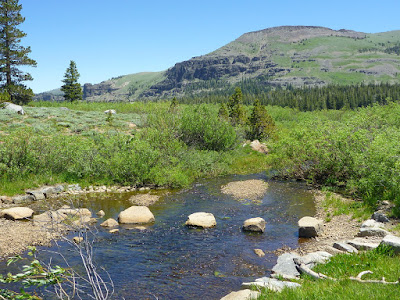 |
| Showers Lake with hanging meadows and cliff-castle |
Showers Lake belongs to a group of subalpine lakes and lakelets between Carson Pass and Echo Summit in the
Upper Truckee River drainage area of the
Sierra Nevada south of Lake Tahoe. These lakes are visited for trout angling, swimming or simply for the panoramic views from the lake sites as well as the meadows and paths between and beyond. Numerous campsites can be found between boulders and conifers around the lakes. On warm summer days, the more accessible lakes, including Showers Lake, can be crowded with both day-visitors and campers. Everyone seems to enjoy this inspiring Sierra lake district and its trails in
Meiss County, California [1-3].
From the
Meiss Meadows Trailhead northwest of the
Carson Pass Information Center (Highway 88), the northbound
Pacific Crest Trail (
PCT)—open for hiking and horseback riding—ascends through a forest of pines, junipers, aspens and scattered boulders. Once the single-track trail leaves the forest, it further ascends across an open slope upward to a
scenic saddle, iris-covered during early summer. Here, you will have southward views of
The Sisters,
Round Top and the
Elephants Back.lava dome. Continuing north, Lake Tahoe comes into view. Then, the PCT winds down into Meiss Meadows and towards the
historic Meiss Cabin, where once the Meiss family spent the summer months fishing, cattle ranching and enjoying snow-bank-frozen ice cream.
 |
| Distances from PCT/TRT junction |
At the trail junction near this historic cabin & stable site, where the
Tahoe Rim Trail (
TRT), coming from
Round Lake, merges with the PCT, a sign shows the distances for northbound travelers: 2 miles to Showers Lake, 6 miles to
Bryan Meadow and 10 miles to
Echo Summit. For a while, the level PCT continues between stands of light forest and meadows. Seasonal trickles or low streams have to be crossed.
 |
| PCT between Meiss Cabin and Showers Lake: stepping stones in front, the volcanic rock formations east of Round Lake in the background |
The trail then ascends toward a forested crest, from which Showers Lake comes into view. After a short descend you will reach the south corner of the lake, where deep mud and dense willows may keep you away from the shore. Most areas around the lake, however, feature needle-covered ground in the shade of pine trees and mountain hemlocks. Tim Hauserman puts it this way [4]:
Showers Lake itself is beautiful (although often crowded with campers). The south side is marshy but the northern side provides great swimming opportunities enhanced by flat granite rocks that reach down to the water. Several camping spots surrounded by hemlock, lodgepole pines, and before summer, mosquitoes, can be found above the north and east sides of the lake.
When we were there on June 21, 2015, a strong wind was blowing, keeping the mosquitoes away.
In topographic maps, the
Showers Lake basin is given an
elevation of above
8,500 feet. There are various paths crisscrossing the half-bowl-shaped basin landscape. The PCT itself passes alongside the northern shore. It continues down below the lake's outlet and then heads up and out of the forest to higher points from where
Dardanelles Lake, Lake Tahoe and Freel Peak can be seen.
References and more to explore
[1]
Carson Pass to Showers Lake:
sites.google.com/site/zbjohnsonadventures/hikes/california-nevada/showers-lake.
[2]
Flowers create colorful path to Showers Lake:
tahoesouth.com/blog/showers_lake_hike/.
[3]
Showers Lake 2003:
www.avidbackpackers.com/htm/trips/show.htm.
[4] Tim Hauserman:
The Tahoe Rim Trail.
Wilderness Press, Berkeley, California,
2002.





















